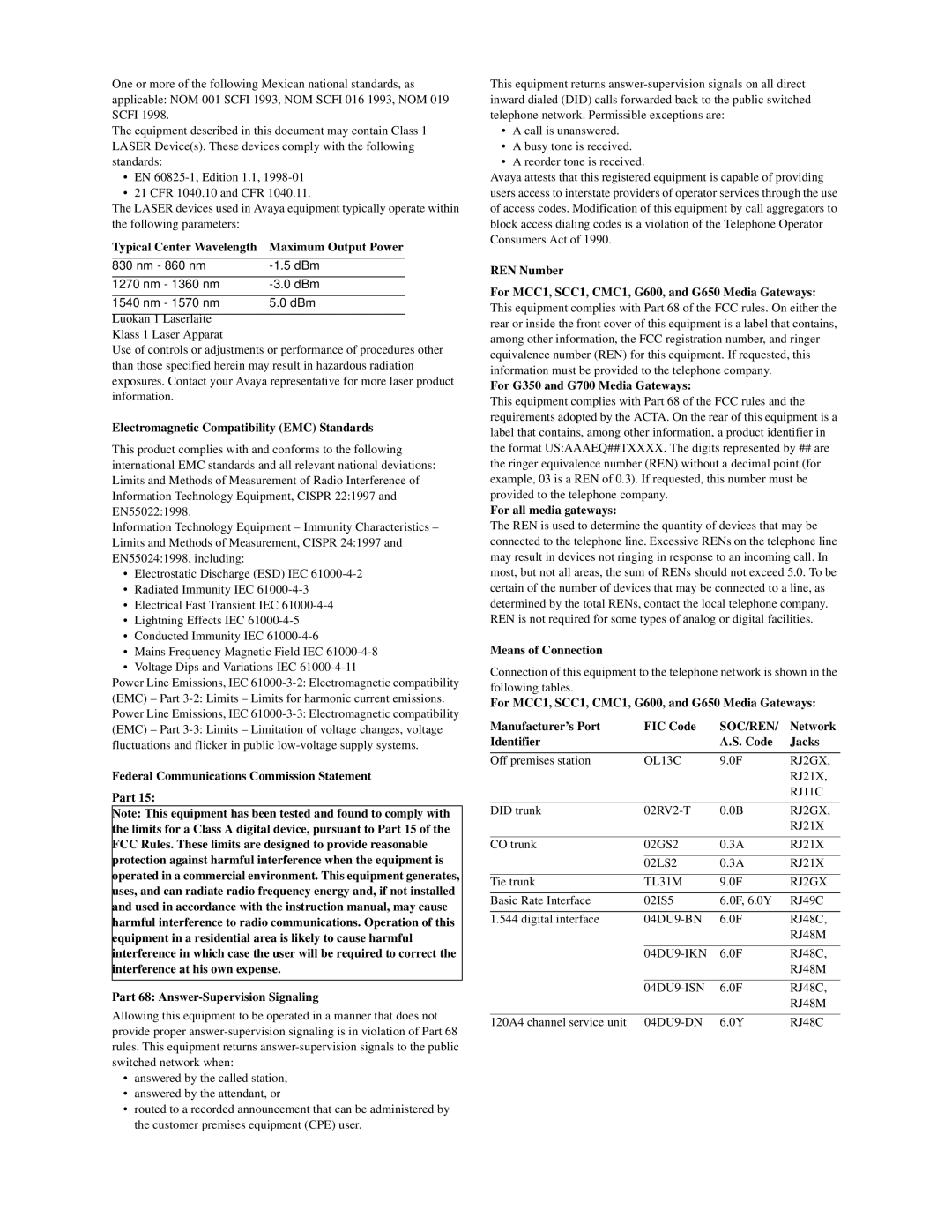One or more of the following Mexican national standards, as applicable: NOM 001 SCFI 1993, NOM SCFI 016 1993, NOM 019 SCFI 1998.
The equipment described in this document may contain Class 1 LASER Device(s). These devices comply with the following standards:
•EN 60825-1, Edition 1.1, 1998-01
•21 CFR 1040.10 and CFR 1040.11.
The LASER devices used in Avaya equipment typically operate within the following parameters:
Typical Center Wavelength | Maximum Output Power |
830 nm - 860 nm | -1.5 dBm |
| |
1270 nm - 1360 nm | -3.0 dBm |
| |
1540 nm - 1570 nm | 5.0 dBm |
Luokan 1 Laserlaite Klass 1 Laser Apparat
Use of controls or adjustments or performance of procedures other than those specified herein may result in hazardous radiation exposures. Contact your Avaya representative for more laser product information.
Electromagnetic Compatibility (EMC) Standards
This product complies with and conforms to the following international EMC standards and all relevant national deviations: Limits and Methods of Measurement of Radio Interference of Information Technology Equipment, CISPR 22:1997 and EN55022:1998.
Information Technology Equipment – Immunity Characteristics – Limits and Methods of Measurement, CISPR 24:1997 and EN55024:1998, including:
•Electrostatic Discharge (ESD) IEC 61000-4-2
•Radiated Immunity IEC 61000-4-3
•Electrical Fast Transient IEC 61000-4-4
•Lightning Effects IEC 61000-4-5
•Conducted Immunity IEC 61000-4-6
•Mains Frequency Magnetic Field IEC 61000-4-8
•Voltage Dips and Variations IEC 61000-4-11
Power Line Emissions, IEC 61000-3-2: Electromagnetic compatibility
(EMC) – Part 3-2: Limits – Limits for harmonic current emissions.
Power Line Emissions, IEC 61000-3-3: Electromagnetic compatibility
(EMC) – Part 3-3: Limits – Limitation of voltage changes, voltage fluctuations and flicker in public low-voltage supply systems.
Federal Communications Commission Statement
Part 15:
Note: This equipment has been tested and found to comply with the limits for a Class A digital device, pursuant to Part 15 of the FCC Rules. These limits are designed to provide reasonable protection against harmful interference when the equipment is operated in a commercial environment. This equipment generates, uses, and can radiate radio frequency energy and, if not installed and used in accordance with the instruction manual, may cause harmful interference to radio communications. Operation of this equipment in a residential area is likely to cause harmful interference in which case the user will be required to correct the interference at his own expense.
Part 68: Answer-Supervision Signaling
Allowing this equipment to be operated in a manner that does not provide proper answer-supervision signaling is in violation of Part 68 rules. This equipment returns answer-supervision signals to the public switched network when:
•answered by the called station,
•answered by the attendant, or
•routed to a recorded announcement that can be administered by the customer premises equipment (CPE) user.
This equipment returns answer-supervision signals on all direct inward dialed (DID) calls forwarded back to the public switched telephone network. Permissible exceptions are:
•A call is unanswered.
•A busy tone is received.
•A reorder tone is received.
Avaya attests that this registered equipment is capable of providing users access to interstate providers of operator services through the use of access codes. Modification of this equipment by call aggregators to block access dialing codes is a violation of the Telephone Operator Consumers Act of 1990.
REN Number
For MCC1, SCC1, CMC1, G600, and G650 Media Gateways:
This equipment complies with Part 68 of the FCC rules. On either the rear or inside the front cover of this equipment is a label that contains, among other information, the FCC registration number, and ringer equivalence number (REN) for this equipment. If requested, this information must be provided to the telephone company.
For G350 and G700 Media Gateways:
This equipment complies with Part 68 of the FCC rules and the requirements adopted by the ACTA. On the rear of this equipment is a label that contains, among other information, a product identifier in the format US:AAAEQ##TXXXX. The digits represented by ## are the ringer equivalence number (REN) without a decimal point (for example, 03 is a REN of 0.3). If requested, this number must be provided to the telephone company.
For all media gateways:
The REN is used to determine the quantity of devices that may be connected to the telephone line. Excessive RENs on the telephone line may result in devices not ringing in response to an incoming call. In most, but not all areas, the sum of RENs should not exceed 5.0. To be certain of the number of devices that may be connected to a line, as determined by the total RENs, contact the local telephone company. REN is not required for some types of analog or digital facilities.
Means of Connection
Connection of this equipment to the telephone network is shown in the following tables.
For MCC1, SCC1, CMC1, G600, and G650 Media Gateways:
Manufacturer’s Port | FIC Code | SOC/REN/ | Network |
Identifier | | A.S. Code | Jacks |
| | | |
Off premises station | OL13C | 9.0F | RJ2GX, |
| | | RJ21X, |
| | | RJ11C |
| | | |
DID trunk | 02RV2-T | 0.0B | RJ2GX, |
| | | RJ21X |
| | | |
CO trunk | 02GS2 | 0.3A | RJ21X |
| | | |
| 02LS2 | 0.3A | RJ21X |
| | | |
Tie trunk | TL31M | 9.0F | RJ2GX |
| | | |
Basic Rate Interface | 02IS5 | 6.0F, 6.0Y | RJ49C |
| | | |
1.544 digital interface | 04DU9-BN | 6.0F | RJ48C, |
| | | RJ48M |
| | | |
| 04DU9-IKN | 6.0F | RJ48C, |
| | | RJ48M |
| | | |
| 04DU9-ISN | 6.0F | RJ48C, |
| | | RJ48M |
| | | |
120A4 channel service unit | 04DU9-DN | 6.0Y | RJ48C |

